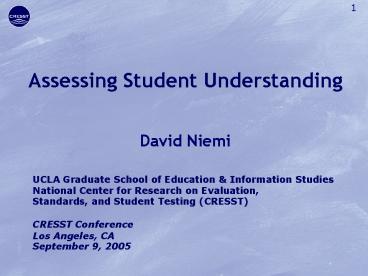Assessing Student Understanding PowerPoint PPT Presentation
1 / 27
Title: Assessing Student Understanding
1
Assessing Student Understanding
- David Niemi
UCLA Graduate School of Education Information
StudiesNational Center for Research on
Evaluation,Standards, and Student Testing
(CRESST) CRESST Conference Los Angeles,
CA September 9, 2005
2
The mile wide, inch deep curriculum
- How wide and deep should it be?
- 1 inch wide and 1 mile deep?
- 1/2 mile wide and 2 inches deep?
3
Example of Instruction
epi 1 0
4
Assessment
epi 1
5
Answer
epi 1 0
6
What would you have to know in order for this to
be meaningful and useful?
- epi 1 0
- What do the symbols mean?
- What is this equation about?
- What can you do with it?
- Whats important about it?
- How does it connect to other topics in
mathematics?
7
Our approach
- Analyze and map the domain based on previous
research and knowledge elicitation - Identify central principles
- Used to build schemas
- Enable inferences, complex problem solving, and
learning - Provide a foundation for advanced learning
- Use models to build assessments at right level of
cognitive demand
8
Research on the Structure of Knowledge
--Chi, Glaser, Rees, 1983
9
Eliciting the Structure of Knowledge
- Experts (scientists, mathematicians, historians,
writers) identify organizing concepts and
principles (big ideas) - Determine related ideas and skills facts,
problems, situations, etc. - Map all ideas and skills
10
Structure of Algebra I KnowledgeCentral
Principles
- 1 Number
- 2 Expressions, Equations, Inequalities
- 3 Functions
- 4 Problem Solving
- 5 Reasoning
- 6 Sets
11
Ideas About Functions
- A function is a mapping between inputs and
outputs such that each input is mapped to one and
only one output. - Many events in the physical world can be modeled
as functions. - Many functions can be represented by algebraic
equations or graphs. - The equation of a linear function can be written
in the form f(x) mx b. - The graph of a linear function is a line.
12
Map of Algebra I Knowledge
13
Task Components for Assessing Complex Learning
- Text or other representation of information
requiring domain knowledge (concepts, principles,
and factual knowledge) - Respond with complex performance
- E.g., explanation, problem solving, knowledge map
- Scoring based on expert performance
14
Examples of Models in Action
- Assessments of history and math understanding
tested with hundreds of students - Scaling up with 300-400,000 students per year in
the districts 2nd largest district - IERI online tools to build assessments
(Assessment Design and Delivery System or ADDS) - New CRESST assessments of mathematics
understanding in grades 6-8, including worked
examples
15
Study of Fifth Grade Students Understanding of
Fraction Representations
- 500 students randomly assigned to instruction on
- Fractions as parts of wholes
- Fractions as rational numbers
- After instruction, students given
- Students performed better with the types of
representations and meanings they had been
taught. - Students who understood the representations
performed better on measures of complex problem
solving.
16
Fractions
17
Fractions
18
Equivalent Fractions
19
Equivalent Fractions
20
Fractions
21
ADDS DesignerSelect Information Source
22
Screenshot from an Animation
23
Two Screenshots From an Animation
1
2
24
Screenshot from a Simulation
25
Results from Studies of Teachers Using ADDS
- Series of experimental studies
- In one study, 33 middle school science teachers
randomly assigned to ADDS and non-ADDS groups - ADDS teachers were more likely to focus on
central ideas and developed more cognitively
complex assessments. - In another experimental study with 17 teachers,
ADDS enhanced the ability of teachers to develop
comparable assessments on the same topic.
26
What have we learned (in the effort to make
evidence based practice a reality)?
- Complex, research-based assessments
- Can be instructionally sensitive, valid measures
of challenging state standards, predictive of
performance on state tests - Can provide info to guide and improve
instruction, - Can be reliably scored.
27
What have we learned?
- Deep understanding is rare or non-existent, but
understanding and use of big ideas can be
improved in a relatively short time. - Information on student understanding and complex
performance is a powerful tool for change and can
be used to help focus and propel capacity
building efforts.

